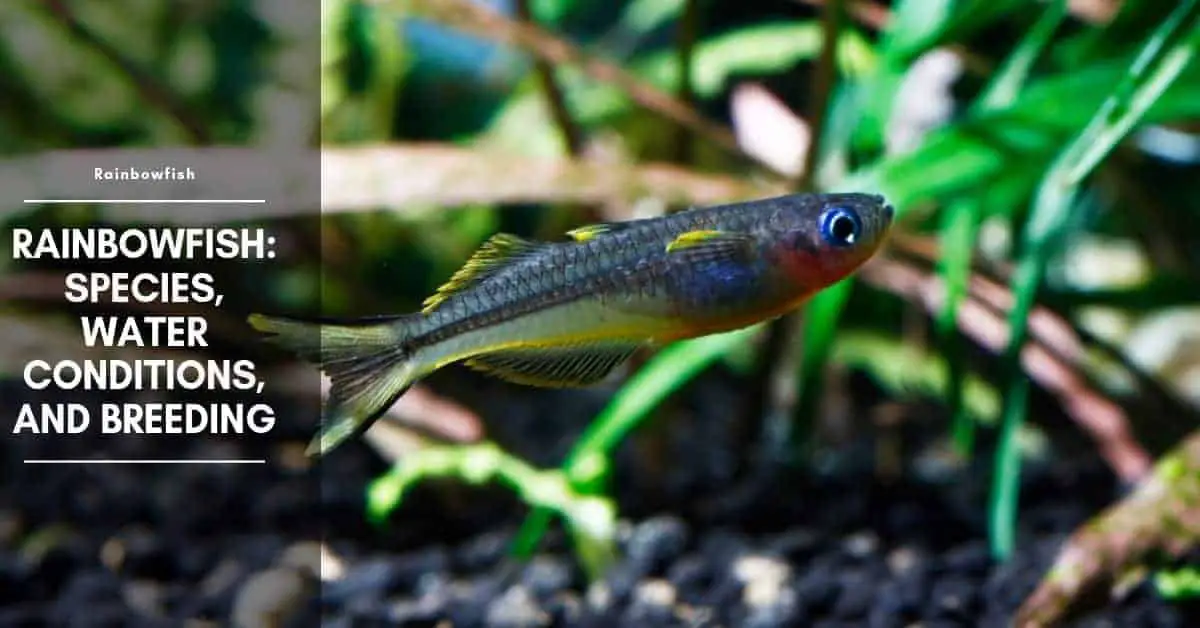Rainbowfishes have been known in the aquarium trade for many years. until recently only a few species have been commonly available. Of these only Telmatherina ladigesi (Celebes rainbowfish), Bedotia geayi (Madagascar rainbowfish), and Melanotaenia splendida (eastern rainbowfish) have made any real impression. The last species is often referred to as Melanotaenia nigrans but the latter was probably not in the hobby until the end of the 1970s.
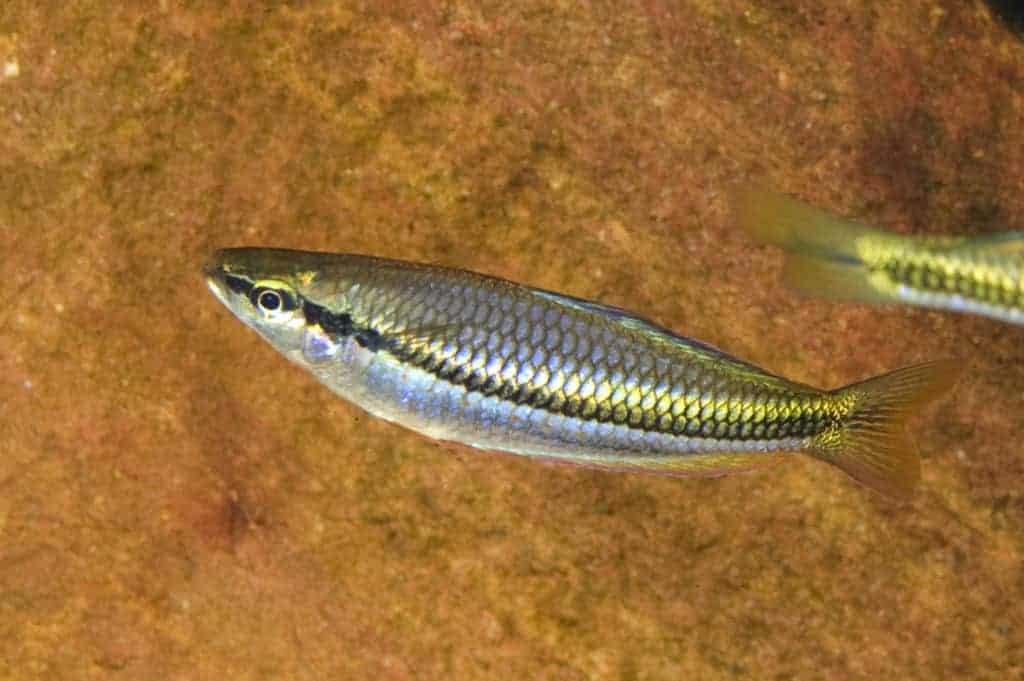
Recently this neglected group has aroused much more interest, with more species available in the shops and still more through the specialist societies which are springing up worldwide. The reasons for their popularity are obvious when you consider the type of fishes we are dealing with here. Most species measure between 3-15 cm (1.2-6 in) as adults and are peaceful, lively fishes that fit in well in most communities. They also have very attractive colors and a hardy disposition, which all adds up to the perfect aquarium fish.
Rainbow Fish Habitat
From the scientific point of view, the group of fishes we aquarists call rainbowfishes are split into three families:- Atherinidae (silversides), Melanotaeniidae (rainbowfishes), and Pseudomugilidae (blue-eyes). They are found in all sorts of habitats, from mountain streams to lowland rivers as well as lakes, ponds, ditches, and swampy regions. We recommend that the new aquarist starts with members of the Melanotaeniidae, such as Melanotaenia, Glossolepis, and Chilatherina, which tend to be the easiest to maintain.
Tank Size And Water Conditions
Provide them with a well-planted aquarium of 100 cm (36 in) or more in length: rainbows are very active fishes and some of these species can grow to in excess of 10 cm (4 in). They do well in soft to medium-hard water (up to say 10-15° dH) but are sensitive to poor water quality and will remain near the bottom with their fins clamped to their bodies if water conditions are not to their liking. Regular partial water changes and a good filtration system will avoid this. Many like alkaline conditions: we suggest Chilatherina bleheri (Bleher’s rainbowfish), Chilatherina campsi (highlands rainbow-fish), Glossolepis wanamensis (Lake Wanam rainbowfish), Melanotaenia boesemani (Boeseman’s rainbowfish), Melanotaenia herbertaxelrodi (Lake Tebera rainbowfish), and Melanotaenia trifasciata (banded rainbowfish).
Iriatherina Werneri
Another species worth mentioning is Iriatherina werneri (filament or threadfin rainbow-fish).
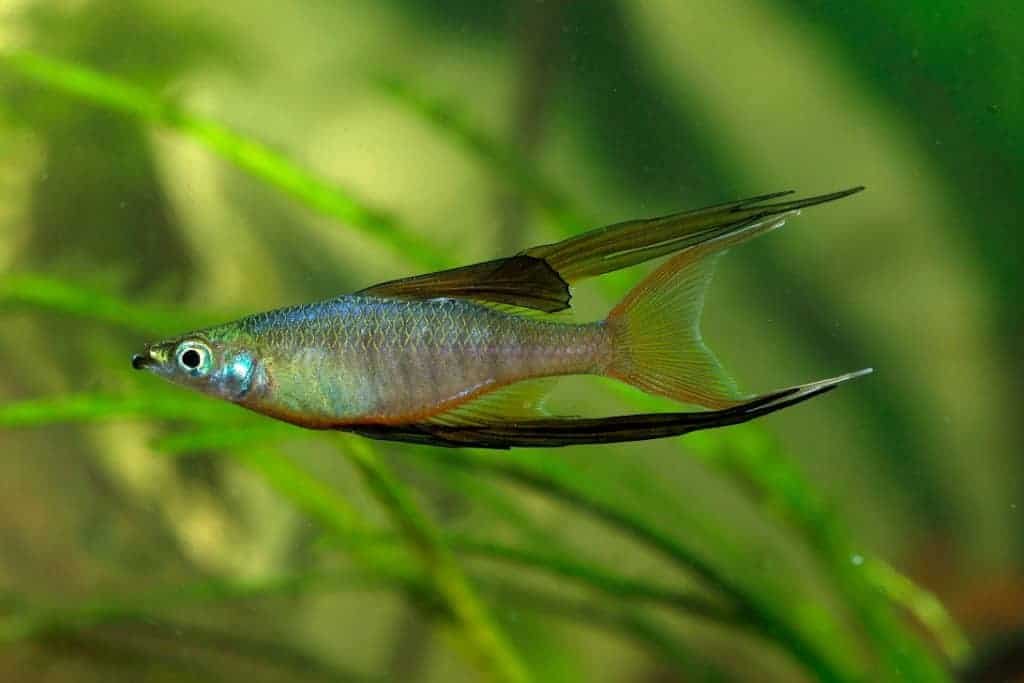
The males are eye-catching because of their long trailing fin filaments and their flag-like dorsal fins. Females are less gaudy. These small “rainbows” grow to at most 3.5 cm (1.4 in) and the females are usually smaller at 3 cm (1.2 in). When first available in the trade only males were sold, but females are now available. They should be kept in a planted aquarium with soft, slightly acid water and a temperature of 24-28°C (75-82°F).
Breeding Threadfin Rainbowfish
They have been bred using either groups or pairs of fishes. The eggs are deposited in clumps of Java moss and hatch in 12 days. The fry requires tiny foods such as rotifers and will even take some fine commercially prepared foods or powdered egg yolk. If using powdered foods of any kind take extra care not to overfeed and pollute the water.
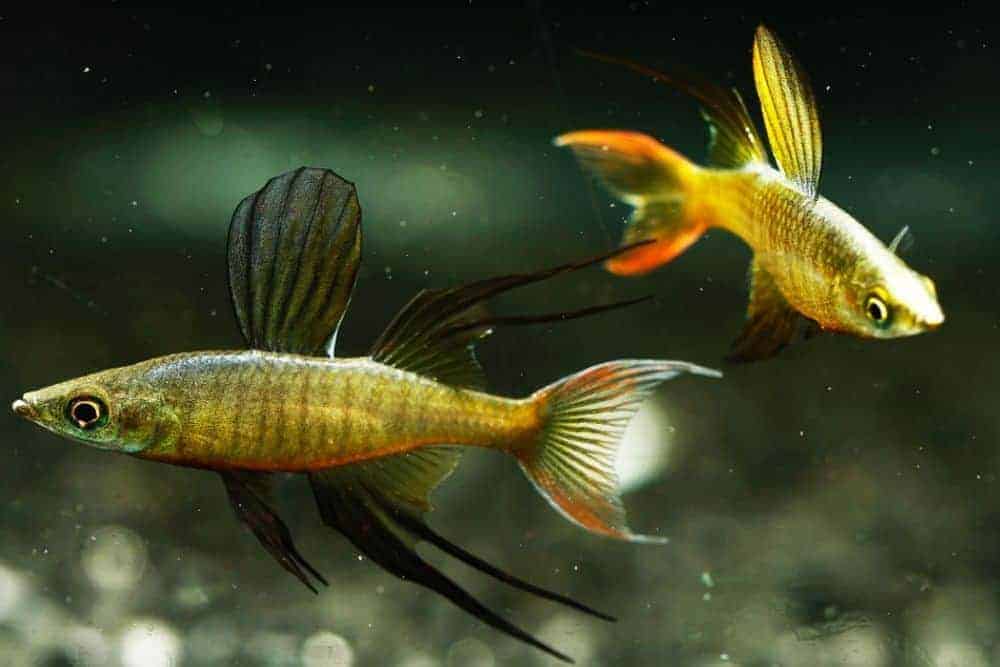
Atherinidae Family
Bedotia Geayi
One member of the family Atherinidae commonly found in aquarium shops is Bedotia geayi (Madagascan rainbowfish). This is a hard water species that needs to be kept in a school of six or more to feel really secure. Regular partial water changes and a clean environment are a must to keep this species in tiptop condition. This is a larger species that can attain 15 cm (6 in) in the aquarium.
Celebes Rainbowfish
The other most commonly encountered member of this family is Telmatherina ladigesi (Celebes rainbowfish). Once again it is a schooling species that prefers to be in a group of six or more and can be sensitive to water quality. Both are hard water species but will adapt to most water conditions provided the change is made slowly and acid conditions are avoided.
Pseudomugilidae
The family Pseudomugilidae includes a group of smaller rainbowfishes which are only just beginning to make an impact on the aquarium trade. There are about ten species in the family but only two have been seen with any regularity in aquarium shops. Pseudomugil signifer (Pacific blueeye), comes from hard, slightly alkaline biotopes and is also found in brackish habitats. They adapt well to most aquarium conditions but do not like acid water. Females are rather drab, having a plain brownish body and clear fins, but males have bright yellow to orange fins with black leading edges. In some strains the anal and dorsal fins are elongated. Maximum size is about 5 cm (2 in) and they will fit in well in a community aquarium with similar-sized fishes.
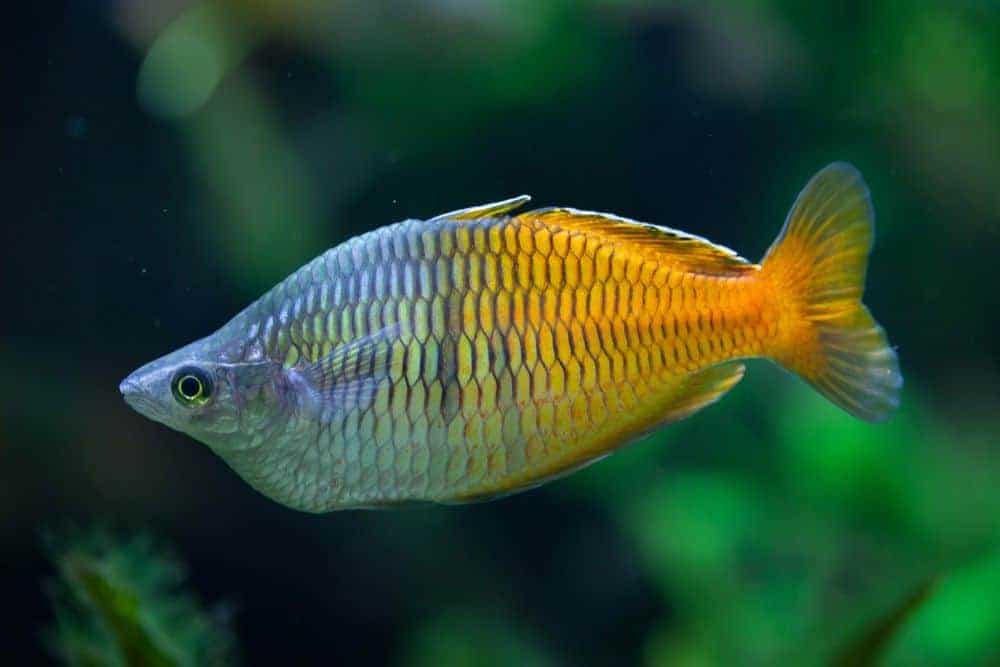
Pseudomugil Furcatus
The other species which can sometimes be found is one of the most beautiful of all the small rainbows, Pseudomugil furcatus. Females are rather plain with just a hint of yellow in the fins, but males have the most spectacular golden yellow coloration which suffuses much of the body and fins. The base of the posterior dorsal fin and the anal fin are black, edged with yellow, and the tail has about six black central rays bounded by six yellow rays above and below. The top and bottom lobes are edged in black.
This is a peaceful hardy species which does well in the aquarium. It grows to only about 4 cm (1.6 in) and makes an ideal inmate for a community of small species. It likes hard alkaline water, and regular partial water changes are a must to keep it in good condition.
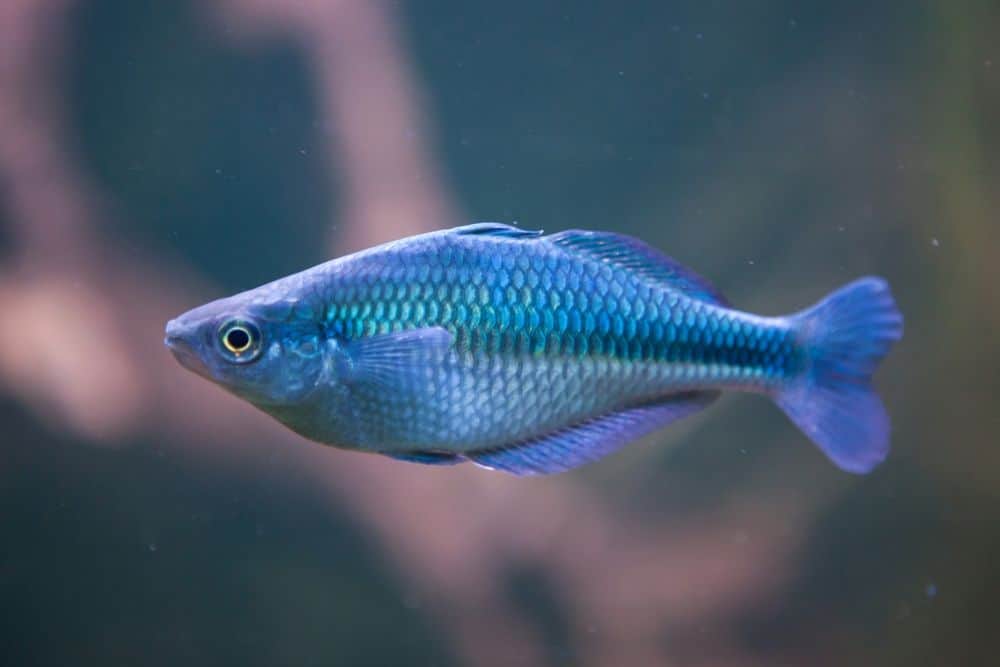
What Do Rainbowfish Eat?
To get both color and size on your rainbows you will need to feed them on plenty of live or frozen foods. They are particularly fond of mosquito larvae, Mysis shrimp, bloodworm, and Daphnia. These foods will also help to bring them into breeding condition.
Breeding Rainbowfishes
Rainbow Fish Eggs
Rainbows spawn by placing their eggs among fine-leaved plants. Most spawn over a period of several days and partial water changes, coupled with early morning sunlight falling on the aquarium, will often act as a trigger. Maybe 20 or so eggs are produced daily over a period of several days (egg numbers vary from species to species and on the size of the parents) and are hung by threads from the plants.
Rainbow Fish Fry
The problem arises when the fry hatch as they do so at the same intervals as the eggs were laid, thus you find you have very tiny, newly hatched fry mixed with those that are a week old. Many hobbyists overcome this by spawning rainbows on mops such as those used for killifishes. It is then easy to pick off the eggs and raise the fry separately in batches.
If you have only a community tank in which to keep your rainbows, a mop can be provided for the fishes to spawn on and removed every day or two to pick off eggs. Raising the fry can be very hard work. In some species, they are minute and require infusoria (Paramecium is very useful if you can get a culture going) and very fine brine shrimp nauplii, but once you have found the right foods and managed to get the hatching times of fishes and foods to coincide, growth of the fry is steady – under no circumstances can it be termed fast.
Feed The Fry
Regular small feeds four to six times a day work best, and during this time the rearing tank needs to be kept scrupulously clean. Sponge filters are very useful but it is also necessary to siphon out any dead brine shrimp before it decays.
Water Changes
Partial water changes also help to maintain water quality. Although many people like to mix rainbow species in the community aquarium, this is not a wise practice if you are intending to breed these fishes, as one female can look very like another and they may interbreed, producing unsaleable hybrids.

Hi, my name is Sean, and I’m the primary writer on the site. I’m blogging mostly about freshwater and saltwater aquariums, fish, invertebrates, and plants. I’m experienced in the fishkeeping hobby for many years. Over the years I have kept many tanks, and have recently begun getting more serious in wanting to become a professional aquarist. All my knowledge comes from experience and reading forums and a lot of informative sites. In pursuit of becoming a professional, I also want to inspire as many people as I can to pick up this hobby and keep the public interest growing.
Read more about Sean.
Please join also my Facebook group.

